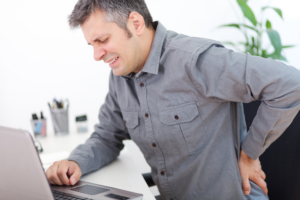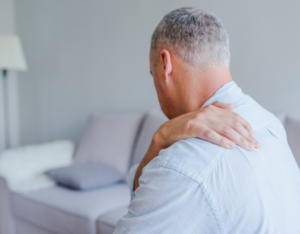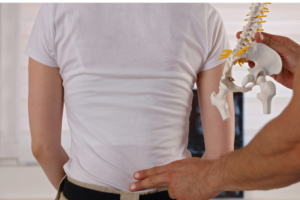
While telecommuting has been slowly growing for years, COVID-19 introduced working from home to a large sector of the world in 2020. One study estimates that 81% of the global workforce experienced some kind of workplace change due to COVID-19 safety measures, and telecommuting was certainly a big part of that.
How is it working out?
Working from home has brought some advantages. People have been able to avoid the commute drain and spend more time with loved ones. They’ve spent less money eating out and drinking lattes.
However, there are drawbacks — including to many individuals’ physical well-being.
The Catch: A Pain in the Neck (and Back)
Medical professionals have noticed a recurring trend as folks spend prolonged amounts of time in home offices: back, neck, and shoulder pain. These musculoskeletal (MSK) disorders are often linked to spinal misalignment.
It makes sense, of course. Most of us weren’t prepared to work at home for over a year — and it’s not over yet. What started out as an improvised situation has become the norm, but many people’s homes simply aren’t designed for daily 9-5 work.
Many modern offices equip their employees with ergonomic equipment with good reason — the benefits are too numerous to ignore. But when you were suddenly asked to work from home, what did you turn to? Kitchen tables and counters? Couches? Beds?
Even the fortunate with a home office didn’t have space for multiple remote working family members, from parents to students. Somebody got the office, and somebody had to clear the bar. Unfortunately, many of these makeshift set-ups offer little back, arm, or wrist support.
Are you reading this on a laptop now? You’re likely working from home on a laptop, too. This means hunching or craning your neck to see the low screen. Not ideal.
But furniture is just one problem. Although commutes might’ve been annoying, at least they got us moving out of the house. Popping down to the building coffeeshop gave you five minutes to stretch your legs. Now, your built-in everyday activity might consist of a <1 minute walk from the bed to the couch.
You might also fall into the trap of overworking at home. Without location change, the boundaries of work and life can easily blur. On top of all of this, gyms, yoga studios, and many group forms of exercise have been shut down for months. And the aches and pains of lockdown start to add up.
Fighting Back against Home Office Back Pain
Since working from home will likely persist for much of 2021 — at the least — what can you do cope?
Hack Your Home Office
The goods news: solutions to upper and lower back pain abound. And many are inexpensive and straightforward.
Start by reconfiguring your home office set-up. You’re trying to meet a few simple standards.
- Make your eye-line level with your computer monitor. Our heads are the heaviest part of our body. Tipping your cranium forward too far can strain the neck. This filters down into shoulder and upper back tension. You’ll hear the phrase “text neck” tossed around to describe this uncomfortable state.
For a laptop, it’s easiest to connect an external keyboard and mouse. Then you’re free to raise the screen height. That process can be lo-fi and cheap, like putting an Amazon box or encyclopedia underneath your laptop.
- Get your elbows as close to 90 degrees as possible when typing. You also want your wrists to feel relaxed and straight. You don’t have to buy a whole new chair, desk, or table to do this. Adjust what you can. That could mean sitting up on a cushion to match a low chair to a high work surface, or vice versa.
- Watch your angles. Leaning forward often places more strain on the lower back and compresses your hip flexors. Hip flexors are the muscles you feel along the front of your hip when you do a runner’s lunge. When they’re tight, it can pull your spine out of its natural, curved balance.
Put your computer at a distance where you can lean back a little to take pressure off your back and hip flexors. If you’re using a concave chair, put a pillow or two behind your lower back to encourage its natural curve.
Move with Mindfulness
You can adapt your lifestyle to counter chronic pains. Set a timer to remind you to take a walk. Shoot for sitting intervals of 15, 30, or (at maximum) 45 minutes. It may feel a little contrived at first, but it’s an easy habit to keep once you feel the benefits.
And who says you have to stick to walking? At least once a day, make an effort to do some extended exercise. This could be a yoga video, cycling session, putting on soul music to dance around the living room… whatever. It doesn’t need to be intense. The point is to maintain simple mobility. Small work adds up.
You can also try stretches that alleviate specific aches and pains. Wrist circles feel soothing, and they can be done covertly during Zoom meetings. Child’s pose, thread-the-needle, and simple spinal twists help un-knot shoulders. Head tilts soothe a tired neck. Even five seconds of looking at the ceiling every few minutes can make a difference.
Reach Out to Spinal Professionals
Remember, a relaxed, healthy spine forms the foundation of a relaxed, healthy you. If you are suffering from serious, chronic back pain even after making these changes, it may be worth consulting with one of the medical professionals at Atlanta Spine Clinic.








 Back pain is one of the most debilitating forms of discomfort. Your spine is at the center of your body, so if something goes wrong, you’re likely to be immobile for a while until it heals.
Back pain is one of the most debilitating forms of discomfort. Your spine is at the center of your body, so if something goes wrong, you’re likely to be immobile for a while until it heals. 